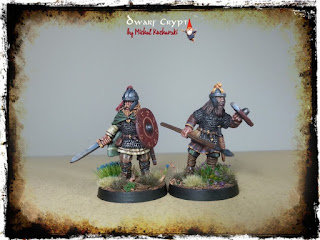[ENG/PL] Athelings (Ætheling) and Thegns in Anglo-Saxon England #1 / Wysoko-urodzeni w Anglosaskiej Anglii #1
Last week I was on vacation on the Polish seaside, so I restricted my blog life to commenting my favorite blogs and gaining knowledge at an excellent Blog Forum Gdańsk, party for best polish bloggers.
Today’s entry, thanks for Footsore Miniatures, will be devoted to the first two miniatures of the high-born „Athelings“ set of dark ages England.
Discuss today models you can find on the official site of the manufacturer in THIS place. I also encourage all of you (if you have not done it yet) of early medieval miniatures lovers, great for games like SAGA.
Ætheling (also spelt Aetheling, Atheling or Etheling) was an Old English term (æþeling) used in Anglo-Saxon England to designate princes of the royal dynasty who were eligible for the kingship.
During the earliest years of the Anglo-Saxon rule in England, the word ætheling was probably used to denote any person of noble birth. Its use was soon restricted to members of a royal family. The prefix æþel- formed part of the name of several Anglo-Saxon kings, for instance Æthelberht of Kent, Æthelwulf of Wessex and Æthelred of Wessex, and was used to indicate their noble birth. According to a document which probably dates from the 10th century, the weregild of an ætheling was fixed at 15,000 thrymsas, or 11,250 shillings, which was equal to that of an archbishop and one-half of that of a king.
The annal for 728 in the Anglo-Saxon Chronicle referred to a certain Oswald as an ætheling, due to his great-great-grandfather being king of Wessex. From the 9th century, the term was used in a much narrower context and came to refer exclusively to members of the house of Cerdic of Wessex, the ruling dynasty of Wessex, most particularly the sons or brothers of the reigning king. According to historian Richard Abels „King Alfred transformed the very principle of royal succession. Before Alfred any nobleman who could claim royal descent, no matter how distant, could strive for the throne. After him, throne-worthiness would be limited to the sons and brothers of the reigning king.“ In the reign of Edward the Confessor, Edgar the Ætheling received the appellation as the grandson of Edmund Ironside, but that was at a time when for the first time in 250 years there was no living ætheling according to the strict definition.
Ætheling was also used in a poetic sense to mean ‚a good and noble man‘. Old English verse often used ætheling to describe Christ, as well as various prophets and saints.
The hero of the 8th century Beowulf is introduced as an ætheling, possibly in the sense of a relative of the King of the Geats, though some translators render ætheling as ‚retainer‘. Since many early Scandinavian kings were chosen by competition or election, rather than primogeniture, the term may have been reserved for a person qualified to compete for the kingship.
Ostatnie 1,5 tygodnia przebywałem na urlopie nad polskim morzem, dlatego ograniczałem moje życie blogowe do komentowania moich ulubionych blogów oraz zdobywania wiedzy na znakomitej konferencji dla blogerów i twórców internetowych Blog Forum Gdańsk
Dzisiejszy wpis, dzięki uprzejmości Footsore Miniatures, poświęcony będzie dwóm pierwszym figurkom z zestawu wysoko-urodzonych „Athelings“ we wczesnośredniowiecznej Anglii.
Omawianie dziś modele możecie odszukać na oficjalnej stronie producenta w TYM miejscu. Zachęcam również do zainteresowania się wszystkich (jeśli jeszcze tego nie zrobiliście) miłośników figurek wczesnośredniowiecznych, znakomitych do gier takich jak SAGA.
Ætheling (zwani także Aetheling, Atheling lub Etheling) to staroangielski termin używany w anglosaskiej Anglii do nazywania książąt dynastii królewskiej, którzy mieli jednocześnie prawo do tronu.
W Anglii, czy wcześniej w anglosaskiej Anglii słowo „ætheling“ prawdopodobnie używane było do przedstawienia osoby szlacheckiej. Jego użycie wkrótce zostało ograniczone do członków rodziny królewskiej. Przedrostek Æ – ukształtowany został na cześć kilku królów anglosaskich, na przykład Æthelberht z Kent, Æthelwulf z Wessex i Æhelred z Wessex, i był używany do wskazania ich szlachetnego pochodzenia.
Według historyka Richarda Abelsa „Król Alfred zmienił zasadę dziedziczenia królewskiego. Przed Alfredem każdy szlachcic, który twierdził, że ma królewskie pochodzenie, niezależnie od tego, jak dalekim był krewnym, mógł żądać tronu dla siebie. Potem zaszczyt ten został ograniczony do synów i braci panującego króla „
Słowo Ætheling było również używane w sensie poetyckim do oznaczania „dobrego i szlachetnego człowieka“. Stare angielskie pisma często używała Ætheling do opisu Chrystusa, a także innych proroków i świętych.
Beowulf , bohater z VIII wieku został przedstawiony jako Ætheling, prawdopodobnie w sensie krewnego króla Geatsa.
Dieser Artikel stammt von einer der angeschlossenen Quellen. Bitte honoriere die Arbeit der Autoren indem du ihren Webseite besuchst.
Artikelquelle besuchen
Autor: DwarfCryptDwarfCryptDwarfCrypt
Powered by WPeMatico







